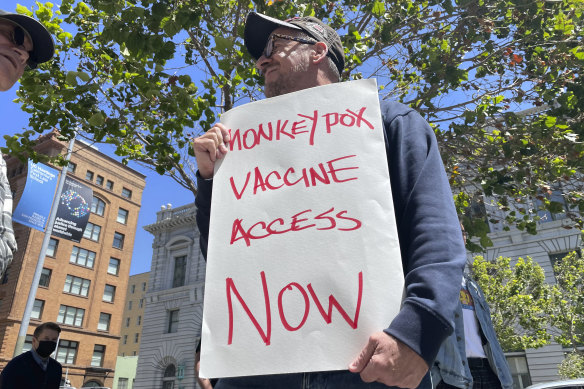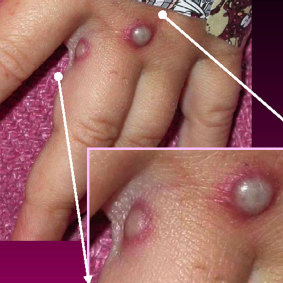This was published 2 years ago
Opinion
Should we be worried about the spread of monkeypox?
By Mike Toole and Raina MacIntyre
On Thursday, the chief medical officer declared that monkeypox was a communicable disease of national significance.
The declaration was entirely appropriate, given the number of cases reported in Australia has just passed 40, bringing to more than 21,000 the number of cases identified in 78 countries since May.

A state of emergency has been declared in San Francisco as monkeypox spreads. Men in the city are demanding more vaccines doses be made available.Credit: AP
This epidemic is clearly growing, and it is particularly important that we take it seriously because as well as not wanting monkeypox to become established in animals and become a long-term reservoir of the virus, the risk of death is highest in children.
The most critical responses are to provide easy access to testing, contact tracing and ring vaccination which involves inoculating an infected person’s closest contacts. New cases need to be identified as soon as possible so that they isolate before infecting other people.
The symptoms of monkeypox start with fever, headache, muscle and joint pain, and enlarged lymph glands. After several days, a rash appears similar to chickenpox but with larger lesions. Classically, the rash is commonly on the face, the palms of the hands and the soles of the feet. In the current epidemic the rash has been more common in the genital or perianal region. The rash lasts around two to four weeks.

The distinctive monkeypox lesions.
In mild cases, treatment is symptomatic, such as pain relief. Antiviral drugs developed to protect against smallpox may be used to treat it and Tecovirimat (TPOXX) and vaccinia immune globulin may be recommended for people who are severely ill or with weakened immune systems.
Monkeypox has long been endemic in parts of sub-Saharan Africa. It is rarely spread by monkeys but obtained its name because the virus was first discovered in a colony of monkeys in a Copenhagen laboratory in 1958. The virus is mainly spread by rodents.
It has been rare since it was first identified in humans in 1970 and then in 2017 cases began rising in Nigeria and the Democratic Republic of the Congo.
In the United States, infections have been increasing rapidly, with 4906 cases in 47 states as of 28 July. The highest number of cases have been in New York and California. San Francisco and the state of New York have declared public health emergencies.
In Australia, 44 cases have been confirmed, including in NSW, Victoria, ACT, Queensland and South Australia. Most infections have been in men who have recently been overseas. However, there has been some community transmission in NSW.
The strain spreading globally has had 50 mutations since an outbreak in Nigeria. But we do not know exactly what these mutations mean.
There are lessons from the early phase of the HIV pandemic in the 1980s which need to be heeded when responding to monkeypox.
While it is not considered a sexually transmitted disease, the monkeypox virus is found in bodily secretions including saliva and semen, and infection can occur through close contact during intimate encounters. It may also occur through handling contaminated clothes, bed linen and towels. In some cases, transmission may occur via large respiratory droplets.

A still from the Grim Reaper AIDS ad.
This infection must not be locked in as one that only affects gay and bisexual men. It’s essential that men who have sex with men are not stigmatised. Public health authorities might encourage them to access sexual health clinics where their privacy will be respected.
The public should not be alarmed nor should they feel complacent.
There is no need for mass TV advertisements like the scary Grim Reaper campaign around HIV in the 80s. But should all be aware of how the virus is transmitted and take necessary precautions when the circumstances dictate. Eyes wide open will serve us well.
The Morning Edition newsletter is our guide to the day’s most important and interesting stories, analysis and insights. Sign up here.